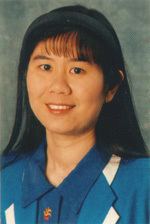Nationality American Fields Computer scientist | Alma mater Berkeley Doctoral advisor John Canny Name Ming Lin | |
 | ||
Notable awards IEEE VGTC VR Technical Achievement AwardUNC Hettleman Prize Residence Chapel Hill, North Carolina, United States | ||
Ming C. Lin is an American computer scientist, the John R. & Louise S. Parker Distinguished Professor of Computer Science at the University of North Carolina at Chapel Hill.
Contents
Research
Lin is known for her work on collision detection, and in particular for the Lin–Canny algorithm for maintaining the closest pair of features of two moving objects, for the idea (with Cohen, Manocha, and Ponamgi) of using axis-aligned bounding boxes to quickly eliminate from consideration pairs of objects that are far from colliding, and for additional speedups to collision detection using bounding box hierarchies. Her software libraries implementing these algorithms are widely used in commercial applications including computer aided design and computer games. More generally, her research interests are in physically based modeling, haptics, robotics, 3D computer graphics, computational geometry, and interactive computer simulation.
Biography
Lin did her graduate studies at the University of California, Berkeley before joining the UNC faculty in 1997. She is the Editor in Chief Emeritus of IEEE Transactions on Visualization and Computer Graphics (2011-2014). She is currently a member of the IEEE Computer Society Board of Governors and a member of Computing Research Association-Women (CRA-W) Board of Directors.
Awards and honors
In 2003, UNC gave Lin their Hettleman Prize for Scholarly and Artistic Achievements, and in 2007, she was named as the Beverly W. Long Distinguished Professor. She has won many best-paper awards for her research, and was given the IEEE Visualization and Graphics Technical Committee 2010 Virtual Reality Technical Achievement Award "in recognition of her seminal contributions in the area of interactive physics-based interaction and simulation for virtual environments." In 2011 she was listed as a fellow of the Association for Computing Machinery for her research in geometric modeling and computer graphics, and she was listed as one of the 2012 IEEE Fellows for her "contributions to real-time physics-based interaction and simulation for virtual environments, robotics and haptics".
